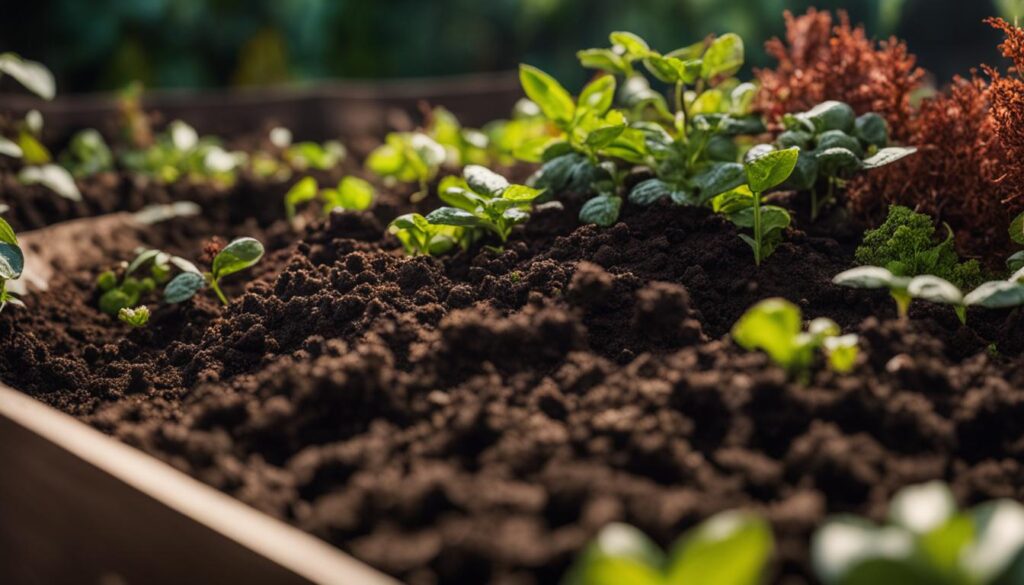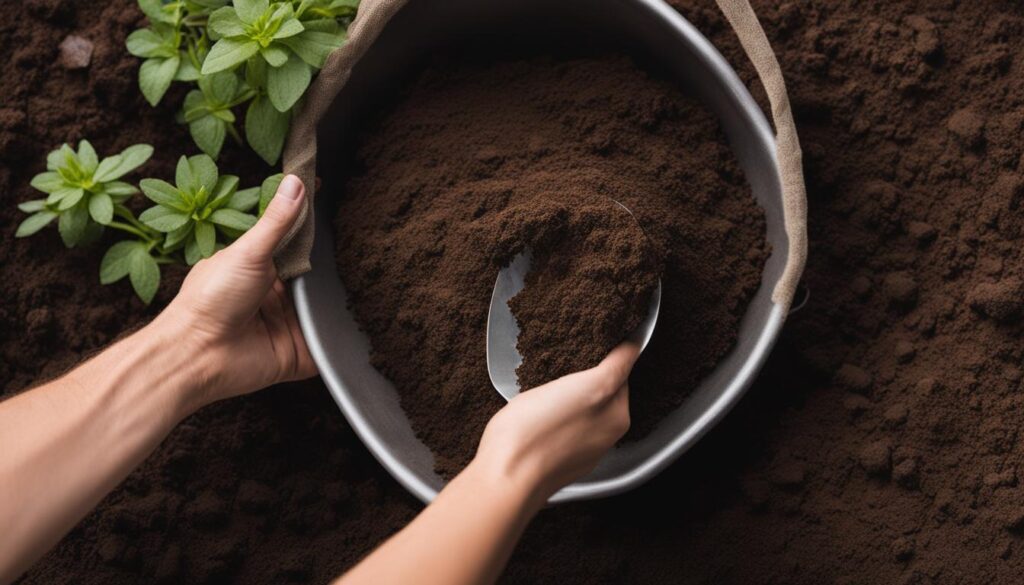Soil plays a crucial role in the success of any garden or landscape. In many cases, the soil found in residential areas is nutrient-poor and may not retain water effectively. Xeriscaping, a water-saving landscaping technique, requires special consideration for soil quality. Organic soil amendments can be used to improve soil structure, nutrient content, and water retention, leading to a more vibrant and lush xeriscape.
Key Takeaways:
- Organic soil amendments are essential for enhancing the success of xeriscaping.
- Xeriscaping is a water-saving landscaping technique.
- Poor soil quality can hinder the growth of xeriscape plants.
- Organic amendments improve soil structure, nutrient content, and water retention.
- Xeriscaping with organic soil amendments creates a vibrant and lush landscape with reduced water requirements.
Importance of Soil Amendments in Xeriscaping
Xeriscaping involves creating a landscape that requires minimal irrigation, making it essential to optimize soil conditions for water retention. Organic soil amendments, such as compost, peat moss, and aged manure, can improve the water holding capacity of sandy and rocky soils, while also opening up air space in clay soils. These amendments enhance the soil’s ability to retain moisture and drain excess water, providing a suitable environment for xeriscape plants to thrive.
Organic soil amendments play a crucial role in xeriscaping by addressing the specific needs of different soil types. Sandy soils have a low water holding capacity, which can lead to drainage issues and inadequate moisture for plants. By incorporating organic matter into sandy soils, the soil structure is improved, creating more space for water retention. Similarly, clay soils have poor drainage properties, which can cause waterlogging and root rot. Organic amendments help break up the clay particles, allowing for better drainage and aeration.
The benefits of soil amendments in xeriscaping extend beyond water retention. These amendments also improve soil fertility by increasing the availability of essential nutrients to plants. Organic matter acts as a nutrient reservoir, slowly releasing valuable elements that support plant growth. Additionally, organic amendments promote beneficial microbial activity in the soil, enhancing nutrient cycling and creating a healthier ecosystem for plants.
The Benefits of Soil Amendments in Xeriscaping:
- Improves water holding capacity in sandy soils
- Enhances drainage and aeration in clay soils
- Increases soil fertility and nutrient availability
- Promotes beneficial microbial activity
- Creates a healthier ecosystem for plants
Soil amendments are a valuable tool in xeriscaping as they address specific soil challenges and create an environment that supports the growth and vitality of drought-tolerant plants. By incorporating organic matter into the soil, you can optimize water retention, improve soil structure, and provide essential nutrients for your xeriscape landscape.
| Soil Type | Recommended Organic Amendments |
|---|---|
| Sandy Soil | Compost, peat moss, aged manure |
| Clay Soil | Compost, perlite, vermiculite |
| Rocky Soil | Compost, aged manure, wood by-products |
Table: Recommended Organic Amendments for Different Soil Types in Xeriscaping
Choosing the Right Organic Soil Amendments
When it comes to xeriscaping, selecting the right organic soil amendments is crucial for creating a thriving and water-wise landscape. The quality and composition of your existing soil will determine which amendments are best suited for improving its structure, nutrient content, and water retention capabilities. Let’s explore some key considerations for choosing the most effective organic soil amendments for your xeriscape garden.
Soil Characteristics and Composition
Before selecting organic soil amendments, it’s important to assess the characteristics of your soil. Take note of its texture, whether it is sandy, clayey, or loamy. Sandy soils tend to drain quickly and have poor water-holding capacity, while clay soils can become compacted and retain too much water. Loamy soils are generally ideal for gardening due to their balanced drainage and water retention properties.
Additionally, consider the pH level of your soil. Most plants thrive in slightly acidic to neutral soil, with a pH range of 6 to 7.5. Testing your soil’s pH level can help determine whether amendments with acidic or alkaline properties are needed.
Organic Amendments for Different Soil Types
Organic soil amendments can greatly enhance soil quality and water retention in xeriscaping. Here are some commonly used amendments according to soil types:
| Soil Type | Recommended Organic Amendments |
|---|---|
| Sandy Soil | Compost, peat moss, wood chips, straw |
| Clay Soil | Compost, aged manure, perlite, vermiculite |
| Loamy Soil | Compost, aged manure |
These organic amendments improve soil structure, increase nutrient content, and enhance water retention, making them suitable for xeriscape gardening in various soil types. Remember to follow proper application techniques and thoroughly incorporate the amendments into the top layer of soil for optimal results.
Benefits of Adding Organic Matter to Soil
Adding organic matter to the soil offers numerous benefits for xeriscape gardens. It enhances soil fertility, promotes beneficial microbial activity, improves soil structure, and enhances water and nutrient retention. By incorporating organic matter into the soil, xeriscape plants can access essential nutrients more effectively and require less water to thrive. Overall, organic matter serves as a foundational element in creating a healthy and sustainable xeriscape landscape.
One of the key benefits of adding organic matter to the soil is improved soil fertility. Organic matter provides essential nutrients, such as nitrogen, phosphorus, and potassium, which are vital for plant growth. It also acts as a slow-release fertilizer, gradually releasing nutrients to plants over time. This helps to maintain a balanced nutrient supply in the soil, supporting healthy plant development in xeriscape gardens.
Additionally, organic matter promotes beneficial microbial activity in the soil. Microorganisms, such as bacteria and fungi, play a crucial role in breaking down organic matter and releasing nutrients in a form that plants can readily absorb. These microorganisms also improve soil structure by creating aggregates, which enhance water infiltration and root penetration. This, in turn, improves the overall health and productivity of xeriscape plants.
“Organic matter serves as a foundational element in creating a healthy and sustainable xeriscape landscape.”
In terms of water and nutrient retention, organic matter acts as a sponge in the soil, holding moisture and preventing it from evaporating too quickly. This is especially important in xeriscape gardening, where water conservation is a primary concern. The organic matter also helps to improve the soil’s ability to retain nutrients, reducing the need for frequent fertilization. By enhancing water and nutrient availability, organic matter contributes to the overall resilience and vitality of xeriscape plants.
Table: Benefits of Adding Organic Matter to Soil
| Benefits | Description |
|---|---|
| Improved Soil Fertility | Organic matter provides essential nutrients and acts as a slow-release fertilizer. |
| Promotes Microbial Activity | Organic matter supports beneficial microorganisms that enhance nutrient cycling and soil structure. |
| Enhanced Water Retention | Organic matter acts as a sponge, holding moisture in the soil and reducing water evaporation. |
| Better Nutrient Retention | Organic matter improves the soil’s ability to retain nutrients, reducing the need for frequent fertilization. |
Organic Amendments for Different Soil Types
Choosing the right organic amendments for your xeriscape garden depends on the type of soil you have. Sandy soils have larger particles and drain quickly, while clay soils have smaller particles and retain water. Let’s explore the best organic amendments for these two common soil types.
Amendments for Sandy Soil
Sandy soils are well-draining but struggle to retain water and nutrients. To improve water and nutrient retention in sandy soil, consider adding the following organic amendments:
- Wood by-products: such as sawdust or wood chips, can increase water holding capacity.
- Straw: when incorporated into the soil, it helps retain moisture.
- Compost: adds organic matter, improves soil structure, and enhances nutrient retention.
By incorporating these organic amendments into sandy soil, you can enhance its ability to retain water and nutrients, creating a more favorable environment for xeriscape plants.
Amendments for Clay Soil
Clay soils have small particles that compact easily and drain poorly. To improve drainage and promote aeration in clay soil, consider incorporating the following organic amendments:
- Bark mulch: helps improve soil structure and promotes better drainage.
- Rotted manure: adds organic matter and improves soil fertility.
- Compost: enhances soil structure and promotes nutrient retention.
By adding these organic amendments to clay soil, you can create a more porous and well-draining soil environment, allowing xeriscape plants to establish healthy root systems.
Table: Organic Amendments for Different Soil Types
| Soil Type | Organic Amendments |
|---|---|
| Sandy Soil | Wood by-products, Straw, Compost |
| Clay Soil | Bark mulch, Rotted manure, Compost |
Best Practices for Incorporating Organic Amendments
Proper soil preparation is essential for the successful incorporation of organic amendments in your xeriscape landscape. By following these best practices, you can ensure that the amendments are effectively integrated into the soil, improving its structure and enhancing water retention.
1. Loosen the Soil
Before applying organic amendments, it is important to loosen the soil to create a favorable environment for plant growth. Use a garden fork or tiller to break up any compacted soil, allowing the amendments to penetrate more easily. Loosening the soil also improves aeration, facilitating the movement of oxygen and nutrients to the plant roots.
2. Remove Debris
Prior to incorporating organic amendments, remove any debris such as rocks, roots, or weeds from the soil. These unwanted materials can hinder the even distribution of amendments and potentially create obstacles for root growth. Taking the time to clear the soil of debris will ensure a clean planting environment and maximize the benefits of the amendments.
3. Even Application
Once the soil is prepared, spread the organic amendments evenly over the soil surface. This ensures that the amendments are distributed uniformly, providing consistent benefits throughout the landscape. Using a rake or garden hoe can help achieve an even application and prevent the concentration of amendments in specific areas.
4. Thorough Incorporation
After spreading the organic amendments, it is crucial to work them into the top layer of soil. Use a garden tiller, shovel, or garden fork to incorporate the amendments to a depth of 6 to 8 inches. This thorough incorporation ensures that the amendments are mixed well with the existing soil, promoting better nutrient availability and water retention.
By following these best practices for incorporating organic amendments, you can create an optimal planting environment in your xeriscape landscape. The proper preparation and application of amendments will enhance soil structure, improve water retention, and provide a solid foundation for the growth of your water-wise plants.
Alternative Inorganic Amendments for Xeriscaping
In addition to organic amendments, certain inorganic amendments can also be used for xeriscaping. These materials, such as pumice, perlite, vermiculite, and sand, offer unique benefits in creating a water-wise and sustainable landscape. While they may not contribute nutritional value to the soil, they play a crucial role in improving soil porosity, drainage, and aeration.
For xeriscape gardens with sandy soils, incorporating inorganic amendments like pumice or vermiculite can help improve water and nutrient retention. These materials act as soil separators, creating pockets of air and drawing moisture towards the plant roots. In contrast, xeriscape landscapes with clay soils can benefit from the addition of perlite or sand. These amendments enhance drainage, prevent soil compaction, and promote a more favorable growing environment.
It’s important to note that inorganic amendments should be used in combination with organic amendments to optimize soil health and water retention. For example, mixing sand with organic amendments like sawdust can improve its overall efficacy in xeriscape landscapes. By blending both organic and inorganic amendments tailored to your soil type, you can create an ideal environment for xeriscape plants to thrive and conserve water.
Benefits of Using Inorganic Amendments:
- Enhances soil porosity and aeration
- Improves drainage in clay soils
- Increases water retention in sandy soils
- Promotes healthy root growth and development
- Creates a water-wise and sustainable landscape
In summary, incorporating inorganic amendments into your xeriscape gardening practices can provide valuable benefits in terms of soil structure and moisture management. By selecting the right combination of organic and inorganic materials, you can create an optimized growing environment for your water-wise landscape. Experiment with different amendments and find the best combination that suits your soil type and plant needs, ensuring a thriving and resilient xeriscape garden.
Soil Improvement Techniques for Water-Wise Landscapes
Creating a water-wise landscape in low desert areas requires specific soil improvement techniques to optimize soil health and enhance water retention. Heavy clay soils prevalent in these regions often become compacted, making it challenging for water to penetrate. Sandy soils, on the other hand, drain quickly and struggle with water retention. By implementing the following soil improvement practices, you can promote healthier soil and maximize water efficiency in your xeriscape landscape:
Loosen the Soil During Planting
Loosening the soil during planting is essential to break up compacted clay and improve water infiltration. This can be done by tilling the soil or using a garden fork to loosen the top layer before adding organic amendments. By creating a loose soil structure, you allow water to penetrate more easily and reach the roots of your xeriscape plants.
Incorporate Organic Mulches
Organic mulches, such as wood chips or straw, act as a protective layer over the soil, reducing evaporation and regulating soil temperature. They also help retain moisture by preventing water from evaporating too quickly. Applying a layer of organic mulch around the base of your plants can significantly improve water retention in your water-wise landscape.
Allow Natural Leaf Litter to Act as Mulch
Incorporating natural leaf litter as a mulching material is an excellent way to improve soil health and water retention. As leaves decompose, they release nutrients into the soil and improve its structure. Additionally, leaf litter acts as a protective layer, minimizing water loss through evaporation. Embrace the natural cycle of trees and plants by allowing fallen leaves to remain on the ground, acting as a natural mulch in your xeriscape garden.
| Soil Improvement Techniques for Water-Wise Landscapes | Benefits |
|---|---|
| Loosen the Soil During Planting | Improves water infiltration into compacted clay soils. |
| Incorporate Organic Mulches | Reduces evaporation, regulates soil temperature, and enhances moisture retention. |
| Allow Natural Leaf Litter to Act as Mulch | Improves soil health, releases nutrients, and minimizes water loss through evaporation. |
By implementing these soil improvement techniques, you can create an environment that optimizes water usage and promotes the long-term health and sustainability of your water-wise landscape.
Benefits of Regrading and Rainwater Harvesting
Regrading your yard and implementing rainwater harvesting techniques can significantly improve soil health and enhance the success of your xeriscape landscape. Regrading involves reshaping the land by creating gentle berms and swales, which help collect and retain rainwater, preventing runoff and erosion. By redirecting water flow and allowing it to percolate into the soil, regrading promotes better water distribution and absorption, benefiting your xeriscape plants.
One of the key advantages of regrading is that it optimizes the gradient of your landscape, ensuring water is distributed evenly and efficiently. By creating gentle slopes, you can prevent water from pooling in certain areas while encouraging its absorption in areas that need it the most. This is particularly beneficial in xeriscaping, where water conservation is paramount.
Rainwater harvesting, another soil improvement technique, complements regrading by collecting and utilizing rainwater for irrigation purposes. This method involves capturing rainfall from rooftops or other surfaces, storing it in barrels or tanks, and redistributing it to your xeriscape landscape. Harvested rainwater is typically free from the salts and minerals found in municipal water, making it ideal for watering your xeriscape plants.
Implementing regrading and rainwater harvesting not only improves soil health but also contributes to the overall sustainability of water usage in xeriscaping. By preserving and efficiently utilizing rainwater, you can reduce your reliance on other water sources and decrease your environmental impact. Embrace these soil improvement techniques to create a thriving and environmentally friendly xeriscape landscape.
Benefits of Regrading and Rainwater Harvesting for Soil Health:
| Benefits | Regrading | Rainwater Harvesting |
|---|---|---|
| Promotes balanced water distribution | ✓ | ✓ |
| Prevents water runoff and erosion | ✓ | – |
| Allows better water absorption | ✓ | – |
| Reduces reliance on municipal water | – | ✓ |
| Preserves rainwater free from salts and minerals | – | ✓ |
| Enhances water efficiency in xeriscaping | ✓ | ✓ |
Planting Trees and Shrubs in Xeriscaping
When it comes to creating a beautiful and sustainable xeriscape landscape, planting trees and shrubs plays a vital role. Not only do they provide shade, habitat for wildlife, and aesthetic appeal, but they also contribute to the overall health and functionality of your xeriscape. However, it’s essential to follow some key tips and guidelines to ensure successful establishment and long-term growth of trees and shrubs in a water-wise landscape.
Choosing the Right Trees and Shrubs
When selecting trees and shrubs for your xeriscape, it’s crucial to choose species that are well-suited to the local climate, soil conditions, and water availability. Native plants are often the best choice as they are adapted to the local environment and require minimal water once established. Look for drought-tolerant varieties that have a proven track record in xeriscape gardening. Consulting with a local nursery or landscape professional can provide valuable guidance in selecting the right plants for your specific xeriscape.
Preparing the Planting Hole
Proper preparation of the planting hole is essential for the successful establishment of trees and shrubs in a xeriscape. Dig a hole that is wider and slightly shallower than the root ball of the plant. Breaking up the soil around the hole and incorporating organic matter, such as compost, can help improve soil structure and drainage. Avoid amending the backfill soil with excessive organic matter, as this can create a “bathtub effect” that traps water around the roots.
Watering and Mulching
After planting, water the trees and shrubs thoroughly to settle the soil and eliminate air pockets. Apply a layer of mulch around the base of the plants, leaving a gap around the stem to prevent moisture buildup and potential rot. Mulch helps conserve soil moisture, suppress weeds, and insulate the roots from temperature fluctuations. Monitor the moisture levels regularly and water deeply and infrequently to encourage deep root growth. Once established, most xeriscape trees and shrubs will require minimal supplemental watering, relying on natural rainfall.
| Tree/Shrub | Water Requirements | Sun Exposure | Mature Size |
|---|---|---|---|
| Desert Willow | Low | Full sun | 15-30 ft |
| Chaste Tree | Low-Moderate | Full sun | 10-20 ft |
| Manzanita | Low | Full sun to part shade | 4-8 ft |
| Yucca | Low | Full sun | Varies with species |
| Texas Red Oak | Moderate | Full sun to part shade | 40-60 ft |
How Do Organic Soil Amendments Help in Enhancing Xeriscape?
Organic soil amendments play a crucial role in enhancing soil for xerophilic plants in xeriscape gardening. These amendments, such as compost, improve soil structure, increase nutrient levels, and enhance water retention capacity. This supports xerophilic plants’ ability to thrive in low-water environments, promoting a healthier and more sustainable landscape.
Conclusion
Organic soil amendments play a crucial role in creating a successful xeriscape landscape. By improving soil health, nutrient content, and water retention, these amendments provide the foundation for a lush and vibrant yard with reduced water requirements.
Selecting the right organic amendments is key to achieving optimal results in xeriscaping. Consider the characteristics of your existing soil and choose amendments such as compost, peat moss, and aged manure that align with your soil’s needs. Incorporate these amendments properly into the soil, ensuring thorough mixing to a depth of 6 to 8 inches. Following recommended soil improvement practices will help create an ideal environment for xeriscape plants to thrive.
Embrace the power of organic soil amendments and transform your landscape into a sustainable and water-wise oasis. With improved soil quality and water retention, you can create a beautiful and resilient xeriscape that requires less irrigation and maintenance. By taking these steps, you can contribute to water conservation efforts and enjoy the benefits of a thriving and environmentally-friendly landscape.














